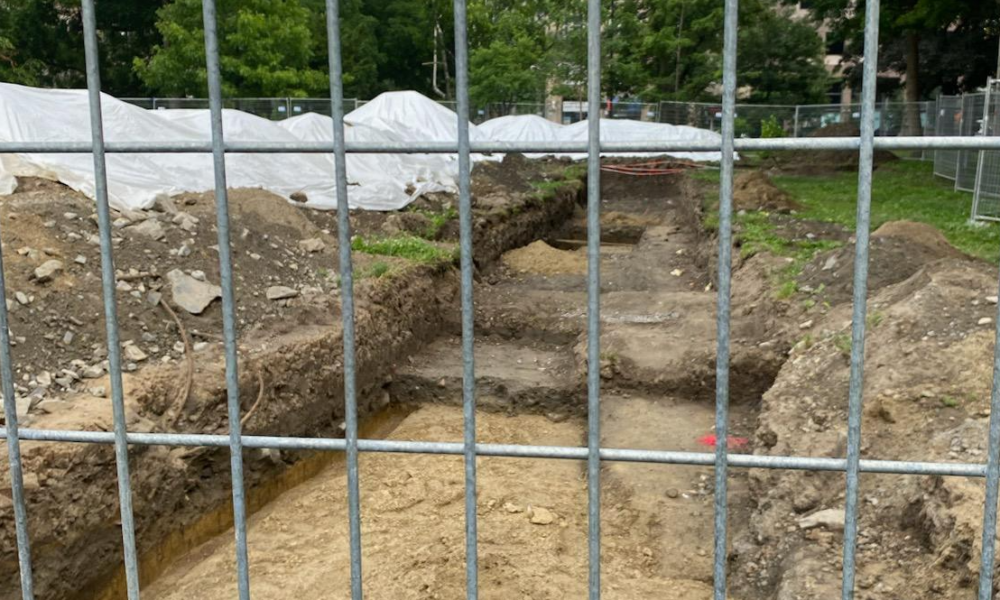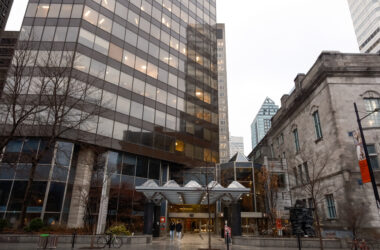CW: Mentions of death and abuse
On June 9, search dogs identified areas that could contain evidence of Indigenous human remains in front of Hersey Pavillon on the site of McGill’s New Vic project. Three weeks later, on June 29, the Kanien’kehá:ka Kahnistensera (Mohawk Mothers) appeared in the Superior Court of Quebec for a case management hearing to discuss potential next steps, including adding more security to the site, expanding the archaeological panel overseeing the excavation, and enforcing transparent communication between parties.
Three human remains detection dogs, led by Kim Cooper from the Ottawa Valley Search and Rescue Dog Association (OVSARDA), surveyed the New Vic project site and identified an area that could contain human remains. In court, Julian Falconer—the lawyer for the Office of the Special Interlocutor—emphasized that the search dogs’ findings do not ascertain that there are remains below ground. In other words, while the dogs have identified the odour of human remains on the land, no actual human remains have been physically identified. Ground penetrating radar, which is a non-intrusive technique used to survey, map, and record land, is set to begin on the identified areas on July 10.
Justice Gregory Moore acknowledged that the plaintiff’s current settlement agreement with McGill, Société Québécoise des Infrastructures (SQI), Royal Victoria Hospital (RVH), City of Montreal, and the Attorney General of Canada does not outline a course of action after the approved archaeological techniques have identified human remains. Furthermore, while McGill and the SQI are contracting service providers to investigate the site, Mohawk Mother Kwetiio told the court that neither the archaeological contracts nor applications for archaeological permits have been shared with the Mothers.
In a written statement to The Tribune, the SQI stated that nothing definitively confirms or denies the presence of human remains at the moment. Furthermore, they asserted that the Mothers are regularly informed of the implementation of archaeological techniques in accordance with the terms of their settlement agreement.
The Mothers indicated that the defendants have failed to maintain transparent communication, specifically pointing to McGill’s stalled responses to the Mothers’ months-long requests for archives. Moreover, the day after their case management hearing, the Mothers discovered that McGill had begun digging around McGill’s McLennan-Redpath Library complex for its reconstruction, entirely without the Mothers’ knowledge.
In an interview with The Tribune, anthropologist and associate of the Mothers Phillipe Blouin shared that the Mothers fear that the redevelopment is underway both extremely close to potentially undiscovered human remains as well as significant previous findings of an ancient Iroquoian village’s remains in 2016 at the Dawson Site located by Sherbrooke and Peel St.
“We don’t know even if there are Indigenous [cultural] monitors involved in this archaeological investigation, or if it’s just this private firm Ethnoscop,” Blouin said. “We do not know if the results will be made public, or if there’s going to be bioarchaeologists, or if some precautions [exist] in the case that the human remains are also present, because we know that Mount Royal was a burial site for hundreds if not thousands of years.”
In a written statement to The Tribune, McGill’s media relations officer Frédérique Mazerolle stated that McGill has been following appropriate archaeological procedures in accordance with regulations stipulated for designated heritage sites, such as the McLennan-Redpath Library complex.
“Standard protocol requires that McGill conduct an archeological excavation before starting any large-scale construction project. The archeological survey took place in coordination with the Mohawk Council of Kahnawá:ke,” Mazerolle wrote.
On the same day that the search dogs’ findings were made public, the Quebec government announced plans to carry out a study to determine the feasibility of turning part of the New Vic property into an inter-university hub for research. The New Vic project would occupy 15 per cent of the site.
“It hasn’t even been discussed with us, and we’re the owners of that land. It’s not appropriate to carry out this study while the land title is about to be discussed in court,” Mother Kahentinetha said.
Along with a lack of communication, Kahentinetha shared that insufficient security has come with an upswell of trespassers at the New Vic site. Blouin explained that these security threats existed as soon as the settlement agreement was signed, with trespassers including individuals recreating Ghostbuster videos, unauthorized archaeologists digging pits, and denialists who could potentially steal or destroy evidence.
“Obviously, [the site] is not being taken care of because the public is all over that place. The traditional protocols we have for regard for burial sites are being totally trampled on,” Kahentinetha said.
As the current settlement agreement does not cover how to address such security concerns or how to proceed after human remains are found, Justice Moore gave the Mothers three options going forward: They can recommence litigation, enter a mediation process with the defendants in an effort to revise the original settlement agreement, or modify and expand the archaeological advisory panel. Blouin shared that while the Mothers have until July 14 to decide, they are leaning toward expanding the panel, as litigation would consume more time and resources.
“It seems like the only thing that brings these institutions to collaborate is when the court is involved, and that’s very unfortunate because the Mohawk Mothers don’t want to spend more resources and time fighting [for] something that’s right,” Blouin said. “You know, people thought they were crazy at first, but there are human remains, and they have to be respected.”
A previous version of this article stated that search dogs identified evidence of human remains in front of the Hershey Pavillion. In fact, it was the Hersey Pavillion. The Tribune regrets this error









